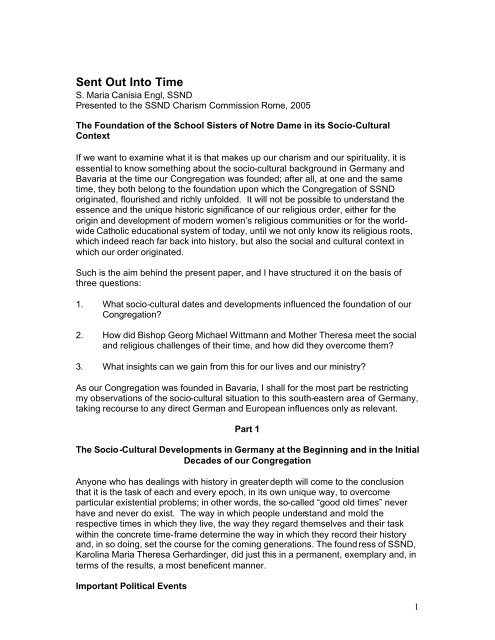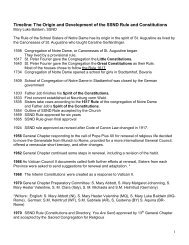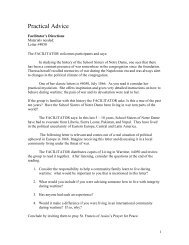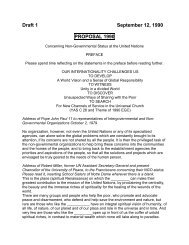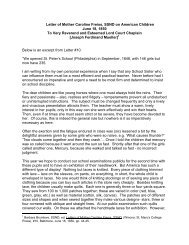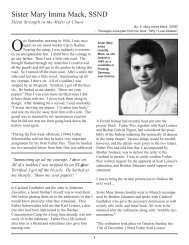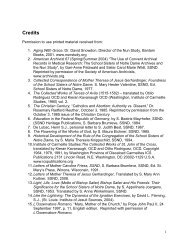essay of S. Maria Canisia Engl - Sturdy Roots
essay of S. Maria Canisia Engl - Sturdy Roots
essay of S. Maria Canisia Engl - Sturdy Roots
Create successful ePaper yourself
Turn your PDF publications into a flip-book with our unique Google optimized e-Paper software.
Sent Out Into Time<br />
S. <strong>Maria</strong> <strong>Canisia</strong> <strong>Engl</strong>, SSND<br />
Presented to the SSND Charism Commission Rome, 2005<br />
The Foundation <strong>of</strong> the School Sisters <strong>of</strong> Notre Dame in its Socio-Cultural<br />
Context<br />
If we want to examine what it is that makes up our charism and our spirituality, it is<br />
essential to know something about the socio-cultural background in Germany and<br />
Bavaria at the time our Congregation was founded; after all, at one and the same<br />
time, they both belong to the foundation upon which the Congregation <strong>of</strong> SSND<br />
originated, flourished and richly unfolded. It will not be possible to understand the<br />
essence and the unique historic significance <strong>of</strong> our religious order, either for the<br />
origin and development <strong>of</strong> modern women’s religious communities or for the worldwide<br />
Catholic educational system <strong>of</strong> today, until we not only know its religious roots,<br />
which indeed reach far back into history, but also the social and cultural context in<br />
which our order originated.<br />
Such is the aim behind the present paper, and I have structured it on the basis <strong>of</strong><br />
three questions:<br />
1. What socio-cultural dates and developments influenced the foundation <strong>of</strong> our<br />
Congregation<br />
2. How did Bishop Georg Michael Wittmann and Mother Theresa meet the social<br />
and religious challenges <strong>of</strong> their time, and how did they overcome them<br />
3. What insights can we gain from this for our lives and our ministry<br />
As our Congregation was founded in Bavaria, I shall for the most part be restricting<br />
my observations <strong>of</strong> the socio-cultural situation to this south-eastern area <strong>of</strong> Germany,<br />
taking recourse to any direct German and European influences only as relevant.<br />
Part 1<br />
The Socio-Cultural Developments in Germany at the Beginning and in the Initial<br />
Decades <strong>of</strong> our Congregation<br />
Anyone who has dealings with history in greater depth will come to the conclusion<br />
that it is the task <strong>of</strong> each and every epoch, in its own unique way, to overcome<br />
particular existential problems; in other words, the so-called “good old times” never<br />
have and never do exist. The way in which people understand and mold the<br />
respective times in which they live, the way they regard themselves and their task<br />
within the concrete time-frame determine the way in which they record their history<br />
and, in so doing, set the course for the coming generations. The foundress <strong>of</strong> SSND,<br />
Karolina <strong>Maria</strong> Theresa Gerhardinger, did just this in a permanent, exemplary and, in<br />
terms <strong>of</strong> the results, a most beneficent manner.<br />
Important Political Events<br />
1
Born in 1797, Karolina Gerhardinger grew up in a time <strong>of</strong> great political, social and<br />
cultural turbulence. She was endowed with a keen intellect. As a child in her parents’<br />
house in Stadtamh<strong>of</strong> and, from 1803, as a pupil with the Canonesses <strong>of</strong> Notre Dame,<br />
she was well aware <strong>of</strong> the effects <strong>of</strong> the French Revolution and the Napoleonic<br />
Wars. 1 The “Reichsdeputationshauptschluss” <strong>of</strong> 1803 sanctioned and accelerated the<br />
secularization <strong>of</strong> ecclesiastical property and the dissolution <strong>of</strong> most <strong>of</strong> the<br />
monasteries. From today’s point <strong>of</strong> view, the closing <strong>of</strong> the school and the Notre<br />
Dame convent in Stadtamh<strong>of</strong> in 1809 turned out to be one <strong>of</strong> the first decisive<br />
changes in the course <strong>of</strong> Karolina Gerhardinger’s life. As a young teacher, she<br />
experienced not only the up-and-coming Kingdom <strong>of</strong> Bavaria, but also the political<br />
tension between the old European aristocratic powers, who were striving to restore<br />
the previous situation, and liberal powers, demanding liberty for the middle classes<br />
and national unity. In 1848, Mother Theresa returned from America to a country in<br />
revolutionary turmoil, where the first German National Assembly had just been<br />
convened in Frankfurt and the bourgeois intelligentsia were adamantly demanding<br />
their right to liberty. Mother Theresa’s supporter and patron, King Ludwig I <strong>of</strong><br />
Bavaria, had to abdicate the throne in favor <strong>of</strong> his son. During the next 22 years, she<br />
and her sisters were to experience two further wars: in 1866 (on the way to German<br />
unification) the so-called War in Germany, and in 1870/71 the Franco-Prussian War.<br />
In 1871, eight years before her death, the German Reich was finally founded and,<br />
under Bismarck’s power politics, strove to gain hegemony in Europe.<br />
Cultural and Intellectual Life<br />
For reasons <strong>of</strong> space, I have only been able to briefly outline such political events; far<br />
more significant in a direct sense for the foundation and development <strong>of</strong> our<br />
Congregation, however, were the cultural and intellectual life <strong>of</strong> the time, and above<br />
all the social changes that were taking place when Mother Theresa was alive. The<br />
French Revolution, the repercussions <strong>of</strong> which characterized the whole <strong>of</strong> the 19 th<br />
century, was in principle the political consequence <strong>of</strong> the philosophy <strong>of</strong> rationalism<br />
and the Enlightenment. This new way <strong>of</strong> thinking in the 18 th century not only freed<br />
people from unreasoned patterns <strong>of</strong> thought handed down throug h the generations<br />
and from social and religious restrictions; it also robbed them <strong>of</strong> the security, hitherto<br />
taken for granted, that in principle a certain order governed their lives and religion<br />
would grant them refuge. Now, society in the old world was soon out <strong>of</strong> joint. Rather<br />
like the times we live in today, there must have been a feeling <strong>of</strong> uncertainty as to<br />
what was happening, now that old structures were breaking down. On the other<br />
hand, we must not forget that it was especially in Germany that this new thinking also<br />
gave birth to some <strong>of</strong> the most prolific epochs in artistic creativity, particularly in the<br />
fields <strong>of</strong> music and literature. The 83 years <strong>of</strong> Mother Theresa’s life encompassed the<br />
cultural epochs <strong>of</strong> “Storm and Stress”, Classicism, Romanticism, Biedermeier and<br />
Realism 2 . In one way or another, she would have been affected by the theories <strong>of</strong><br />
nationalism and liberalism, and quite probably came into contact with the philosophy<br />
<strong>of</strong> thinkers like Hegel, Schopenhauer, Marx and Nietzsche.<br />
Social Changes<br />
At any rate, she was directly aware <strong>of</strong> the effects that intellectual movements were<br />
having at the time on the social changes and in particular on the ensuing problems,<br />
problems that she experienced at first hand. Her childhood came to an end in 1809<br />
2
with the abolition <strong>of</strong> the school she loved so much. At the age <strong>of</strong> only 12, she was<br />
faced with the full reality <strong>of</strong> life – in agreeing to become a teacher, a pr<strong>of</strong>ession<br />
which, had she been free to decide, she would not have chosen; and in the<br />
subsequent harsh type <strong>of</strong> training for this pr<strong>of</strong>ession. It was not until the years that<br />
followed that she also increasingly came to regard it as a vocation.<br />
We know nothing about what she dreamt about as a young girl, or rather <strong>of</strong> what she<br />
would have wanted to dream about had she had the time. Yet we do know about her<br />
determination to face the demands that life placed on her and to recognize in these<br />
demands the will <strong>of</strong> God. We also know, thank God, that at the same time she<br />
remained sensitive and glad at heart, and from a very early age acquired a measure<br />
<strong>of</strong> wisdom at which we can only wonder today. Apart from the movements for<br />
freedom, the great social topics <strong>of</strong> the 19 th century were especially the question <strong>of</strong><br />
education (above all for women and girls from the lower classes) and the social<br />
question. For faith and for the church, the resulting problems posed a challenge <strong>of</strong><br />
proportions hitherto unknown, a challenge that in most cases came to be regarded as<br />
a threat. As a result <strong>of</strong> secularisation the monasteries in particular were largely<br />
robbed <strong>of</strong> the resources and the possibilities to continue running the schools that up<br />
till now had been in their charge. The “educational vacuum” that was created as a<br />
result could hardly or at least only unsatisfactorily be filled by the state. Those most<br />
severely affected by this were the children from the middle and lower classes, in<br />
particular girls. The process <strong>of</strong> industrialization, which had already started during the<br />
first thirty years <strong>of</strong> the 19 th century, first <strong>of</strong> all brought about poverty and then the<br />
destitution <strong>of</strong> large sections <strong>of</strong> the lower classes. What as a result <strong>of</strong> globalization<br />
we can watch happening today on a world-wide scale, both economically and<br />
socially, was going on at that time in central Europe: the structures underlying social<br />
ties were breaking down, the gulf between rich and poor was becoming increasingly<br />
wider and wider, the few people that were rich were amassing more and more wealth<br />
while the masses <strong>of</strong> people living in poverty were getting poorer and poorer. Whole<br />
branches <strong>of</strong> craftspeople, such as the weavers, were being deprived <strong>of</strong> the basis <strong>of</strong><br />
their livelihood. In the hope <strong>of</strong> finding a better way <strong>of</strong> making a living, quite<br />
considerable sections <strong>of</strong> the poor population migrated from the countryside to the<br />
towns – where, ultimately, their search was completely in vain. Many died <strong>of</strong><br />
starvation and exhaustion at an early age, leaving behind their usually numerous<br />
children as helpless orphans.<br />
Part 2<br />
The Foundation <strong>of</strong> our Congregation as a Solution to the Social, Religious and<br />
Educational Problems <strong>of</strong> the 19 th Century<br />
Upheaval, wars, the call for liberty and national unity, social questions and political<br />
decisions on education, all <strong>of</strong> which were in urgent need <strong>of</strong> solutions: such was the<br />
world in which Mother Theresa heard the call <strong>of</strong> God, and followed it. Among the<br />
millions <strong>of</strong> her contemporaries living in the same sort <strong>of</strong> situation and suffering as a<br />
result, it was Karolina Gerhardinger who, in her own unique way, also pledged her<br />
life to helping the poor to be free and take account <strong>of</strong> their own human dignity,<br />
thereby overcoming their despair and deprivation.<br />
Our Foundress Heard God’s Call through the Events <strong>of</strong> the Time<br />
3
The social question and the educational problems were not only closely connected,<br />
they were also mutually dependent. This was something Bishop Georg Michael<br />
Wittmann and, along with him, his most able and faithful student, Karolina<br />
Gerhardinger, both recognized. They both understood this perception to be the<br />
mission entrusted to them by God, to face the problems <strong>of</strong> their times. This is why,<br />
immediately after the Notre Dame School in Stadtamh<strong>of</strong> had been shut down,<br />
Wittmann made sure that lessons for the girls were continued. He commissioned his<br />
chaplain, Georg Mauerer, to train three young girls, among them the twelve-year-old<br />
Karolina Gerhardinger, to become teachers. As it was his conviction that the spread<br />
in moral waywardness among young women could only be stemmed if free and<br />
independent female teachers were to teach and educate girls, he devised the<br />
ingenious plan <strong>of</strong> founding a contemporary religious order for women to take on this<br />
task. The idea was that the sisters should not only be capable teachers, but also in a<br />
position to teach in small communities wherever needed and whenever called out.<br />
They were to live in poverty, in order to show solidarity with the poor, thereby<br />
enabling towns and small country parishes, who had only meagre financial resources<br />
at their disposal, to afford their services. Wittmann remained firmly attached to this<br />
belief for more than twenty years, working patiently and single-mindedly at putting it<br />
into practise, despite all the resistance and difficulties he was confronted with.<br />
During this long period, Karolina Gerhardinger proved not only to be a most diligent<br />
teacher, building up and running an exemplary school in Stadtamh<strong>of</strong>, but also a<br />
young woman <strong>of</strong> great spiritual talent and maturity. Together with Wittmann, she<br />
interpreted the foundation as the “work <strong>of</strong> God” and placed herself unconditionally in<br />
the service <strong>of</strong> this mission.<br />
Mother Theresa Constantly Obeyed Her Conscience<br />
This was the reason why, even when Wittmann died on 8 March 1833, she did not<br />
permit herself to stray from her path, nor could she have been prevented from<br />
opening the first convent <strong>of</strong> our Congregation in Neunburg vorm Wald on 24 October<br />
1833, striving with enormous single-mindedness and speed from then on to spread<br />
the Congregation. Against all odds, both internally and externally, she spent her<br />
whole life doing only what she perceived to be the will <strong>of</strong> God. It was in this that her<br />
strength consisted; yet it was also in this that the great trials in her life she would<br />
have to endure were founded. When, in 1858, amidst the conflicts over the<br />
constitution <strong>of</strong> her order, she writes, “Follow your guiding star. It will lead you safely<br />
to Jesus,” 3 she also shows us what it is that gives her her sole security: the insight <strong>of</strong><br />
her conscience, given to her by God.<br />
It was not only that there were no models on which to fashion the foundation <strong>of</strong> her<br />
religious community; her whole intention was most unusual, if not to say<br />
revolutionary, for it contradicted both the spirit <strong>of</strong> the age and the church tradition <strong>of</strong><br />
religious orders. The Enlightenment had left its mark on bourgeois society, which<br />
now mistrusted any new religious community at a time when it was believed that the<br />
old monasteries had only just been eradicated. Moreover, the reactions <strong>of</strong> the<br />
church hierarchy, deeply insecure as a result <strong>of</strong> the Enlightenment, ranged from<br />
amazement to indignation at the courage <strong>of</strong> a woman presumptuous enough, as<br />
General Superior, to head a congregation <strong>of</strong> women that would not stop growing and<br />
was spreading out over two continents. Moreover, it was impossible for a number <strong>of</strong><br />
secular and church <strong>of</strong>ficials and decision-makers to understand the fact that, on the<br />
one hand, the School Sisters <strong>of</strong> Notre Dame were far ahead <strong>of</strong> their time regarding<br />
4
oth their educational and teaching concepts, and the organization <strong>of</strong> their schools,<br />
and yet, on the other hand, that they wanted to connect their open-mindedness in<br />
worldly matters and outstanding practical competence with a traditional type <strong>of</strong><br />
secluded life in a convent.<br />
The fact that Mother Theresa held to the principle <strong>of</strong> a convent life and above all to<br />
the constitution <strong>of</strong> the Congregation as prescribed by Bishop Wittmann was<br />
interpreted by the Archbishop <strong>of</strong> Munich and Freising, Karl August Graf von Reisach,<br />
as the obstinacy <strong>of</strong> a domineering woman, which he was determined to break once<br />
and for all. Hence, on 22 April 1852, he appeared at the Anger Convent,<br />
accompanied by his vicar general and secretary, and demanded that Mother Theresa<br />
and all the sisters <strong>of</strong> the Motherhouse immediately submit to his episcopal authority;<br />
otherwise, he threatened to excommunicate them.<br />
There seemed to be no way out for Mother Theresa, which is why her response<br />
under the circumstances is a shining example <strong>of</strong> spiritual wisdom, freedom and<br />
greatness, and as such is one <strong>of</strong> the most valuable legacies she has bequeathed to<br />
us School Sisters <strong>of</strong> Notre Dame: she knelt down before the Archbishop and<br />
declared, “I shall submit to your Grace’s jurisdiction, provided that this does not<br />
contradict the will <strong>of</strong> God or my conscience.” 4<br />
In Everything She Did, She Served Life<br />
Mother Theresa was able to be so courageous, so steadfast, and so staunchly<br />
imperturbable because she was never searching for herself; the only important issue<br />
for her was the honor <strong>of</strong> the living God and the salvation <strong>of</strong> the people to whom she<br />
felt committed. Her sharp intellect would always immediately perceive the core <strong>of</strong> an<br />
issue, <strong>of</strong> a need, <strong>of</strong> a task; and her heart full <strong>of</strong> love would not spare her any trial or<br />
tribulation in single-mindedly taking the right path. After meeting her once, King<br />
Ludwig I <strong>of</strong> Bavaria said, “This lady knows what she wants, and what she wants is<br />
eminent and noble.” 5 From the beginning <strong>of</strong> the foundation and almost throughout her<br />
whole life, such “great thinking”, such absolute determination brought Mother<br />
Theresa misunderstanding, underestimation and calumny. Again and again, she was<br />
denounced not only to the church and state authorities but also to her patrons, by<br />
those that envied her, as being arrogant, domineering and wasteful. There was even<br />
many a sister who could not follow her magnanimity and thus felt obliged to lodge a<br />
protest against her plans. This happened, for instance, in 1838/39: while the<br />
Congregation was still in its infancy, Mother Theresa set about establishing the first<br />
higher school in Amberg; a few petty-minded sisters were <strong>of</strong> the opinion that, by<br />
Founding such schools, all Bishop Wittmann had been aiming at was a simple,<br />
practical type <strong>of</strong> basic education for young girls in so-called “elementary schools for<br />
ordinary people”. Mother Theresa opposed such narrow-minded interpretations by<br />
remaining steadfast in her conviction that the situation at the time made it absolutely<br />
essential that girls and women, especially those from the lower classes, should be<br />
educated as comprehensively as possible, in particular in foreign languages; only<br />
then would they be in a position to earn themselves a living on their own. It was<br />
precisely in this way, however, that she created the decisive preconditions for women<br />
to become independent and develop their personal freedom.<br />
In this way, Mother Theresa spoke up for the emancipation <strong>of</strong> women from inhumane<br />
dependence, with determination, quite unpretentiously, as if it went without saying,<br />
and long before the first feminists entered the fray in Europe. And she did so in the<br />
5
same way she tackled everything: in a manner that was practical, purposeful and<br />
competent.<br />
She was not the one to develop fancy socio-political or educational theories and write<br />
academic papers; instead, she acted quickly and energetically, wherever and<br />
whenever she saw there was a challenge to meet. She knew what her mission was<br />
and what possibilities she had – and applied them with enormous confidence in God.<br />
Once, when she was in great distress, she wrote, “When the Lord blesses us, a little<br />
bread will suffice for many”. 6<br />
In the female teachers’ seminary that she founded (it was, by the way, the first one in<br />
Bavaria and most probably the very first in Germany), she carefully ensured that her<br />
sisters were trained in exemplary fashion so that they would be in a position to give<br />
their best in their schools.<br />
Together with her sisters, she addressed the various needs <strong>of</strong> the time in an attentive<br />
and adaptable way, developing educational and training institutions tailor-made for<br />
each individual concrete situation. She founded<br />
• elementary schools to enable all social classes to receive a sound basic<br />
education,<br />
• schools <strong>of</strong> further education for the additional training <strong>of</strong> young women who<br />
had left school,<br />
• higher schools for fostering especially gifted girls.<br />
Possessing great empathy for the needs and deprivation <strong>of</strong> others, Mother Theresa,<br />
inventive as she was, set up a number <strong>of</strong> out-<strong>of</strong>-school facilities 7 , courageously sent<br />
her sisters abroad and out into the New World 8 . She especially loved and was<br />
devoted to the poor orphans, for whom she spared no effort in looking for ways and<br />
means to make a home for them in which they could live happily and thrive. The<br />
outstanding feature <strong>of</strong> the ministry <strong>of</strong> the first sisters was the high quality <strong>of</strong> their<br />
work. Mother Theresa was <strong>of</strong> the opinion that the best was only just about good<br />
enough for the children, for it was in them that she saw the chosen loved-ones <strong>of</strong><br />
God; it was through them that she felt able to serve Jesus. Thus, it was hardly<br />
surprising that, more and more, her educational and traini ng institutions were<br />
considered exemplary, and were very sought-after everywhere. Today, we might well<br />
wonder how Mother Theresa was ever able to master the enormous workload that<br />
she had 9 , not to mention worrying about building up the Congregation, about the<br />
future <strong>of</strong> her foundation, and not to mention all the threats and attacks she had to<br />
fend <strong>of</strong>f; to all this, there is but one answer: it was because she did everything out <strong>of</strong><br />
unselfish love. She never sought personal recognition; before making a decision, she<br />
never asked what consequences or inconvenience might arise for her personally; at<br />
all times, it was simply the “Work <strong>of</strong> God” that stood at the forefront <strong>of</strong> her work and<br />
her worries. Above all, her letters from America to Matthias Siegert 10 demonstrate<br />
quite clearly how very much she was subject to the ideas and patterns <strong>of</strong> thought<br />
prevalent at the time in her Bavarian homeland. Yet they also show how, through her<br />
love and her so-called daycare centers. Here, the children and youngsters could feel<br />
safe and sound, give free rein to their excess energy whilst playing, develop their<br />
creative faculties, learn good social behavior and, not least <strong>of</strong> all, they could be<br />
supervised doing their homework. Trusting in God, she managed to break through<br />
these restrictions. Mother Theresa was great in contemplative prayer. It was from<br />
her constant connection to God that she drew the enormous strength which we<br />
6
admire her for; this is how she summoned the courage and stamina to dare to set out<br />
on a long, arduous and extremely dangerous journey across the ocean by ship, not<br />
even 15 years after the foundation <strong>of</strong> the Congregation. It was not a thirst for<br />
adventure that motivated her, but quite simply the love for the impoverished children<br />
<strong>of</strong> German immigrants, whose education nobody cared about in a country populated<br />
predominantly by the <strong>Engl</strong>ish and the Irish. For their sake she withstood not only the<br />
great physical strain, but also the discouraging reactions <strong>of</strong> the bishops, most <strong>of</strong><br />
whom were <strong>of</strong> Irish origin. Undaunted and patient, she put up with disappointments,<br />
setbacks, failures and humiliation, for she was well aware that she was in the service<br />
<strong>of</strong> “God’s Cause”. 11 It was Mother Theresa’s unique and especial charism to<br />
convincingly fulfill in her own spiritual life the “unity <strong>of</strong> spirit” among the sisters that<br />
she was so concerned about. For her there was no separating her direct connection<br />
to God any more from her extremely active life, no separating her contemplation <strong>of</strong><br />
an action and putting it into practise. Everything she did was pro<strong>of</strong> <strong>of</strong> the connection<br />
between God and her spirit, and in everything she did this connection became visible<br />
and came to fruition.<br />
Part 3<br />
Our Charismatic and Spiritual Legacy as our Mission<br />
We can basically only identify with Mother Theresa and her spirituality truly and<br />
properly if we understand it as the legacy and the mission to translate the charism <strong>of</strong><br />
the School Sisters <strong>of</strong> Notre Dame in such a way that we can apply it to today, thereby<br />
once again making it bear fruit. Here is neither the time nor the place to reflect upon<br />
our charism in detail 12 ; our task is merely to become aware that, like every generation<br />
<strong>of</strong> School Sisters, we have been called upon to recognize the will <strong>of</strong> God in the signs<br />
<strong>of</strong> the times and the mission for our time today, in order to be able to fulfil them in a<br />
determined and unconditional manner.<br />
Our Testimony in this World<br />
Although there are parallels, in many respects the socio-cultural conditions in which<br />
we live differ from the time <strong>of</strong> Mother Theresa and the first School Sisters, and yet<br />
they are by no means any less problematical. The comparably limited horizons<br />
people had at the time <strong>of</strong> the foundation have not least <strong>of</strong> all been widened by<br />
today’s modern means <strong>of</strong> communication; this has resulted in a universal and, even<br />
for spiritual life, dangerous-looking type <strong>of</strong> globalism. We are faced with problems<br />
and deprivation that very <strong>of</strong>ten look to be apocalyptic, thereby tempting us to resign,<br />
as if paralyzing ourselves. We feel helpless when confronted with all the natural<br />
catastrophes that occur, the uninhibited increase in military weapons, the<br />
senselessness <strong>of</strong> war, the desperate fanaticism behind terrorism, the rise in<br />
unemployment in industrial countries, starvation and destitution <strong>of</strong> whole peoples and<br />
social injustice as it spreads throughout the world. No less seldom, we are confused<br />
by the plurality <strong>of</strong> opinions and values; scared, resigned and depressed, we are in<br />
danger <strong>of</strong> withdrawing into the apparently safe little world <strong>of</strong> an individualized, at<br />
times even fundamentalistic type <strong>of</strong> piousness – or, something that is possibly even<br />
worse, to wear ourselves down by resorting to short-term actionism without seriously<br />
thinking beforehand. We only have our faith to set against such temptations, and the<br />
conscious memory <strong>of</strong> what we once determined, whose call we once followed, and<br />
that no more, but also no less, is expected <strong>of</strong> us than <strong>of</strong> Mother Theresa,<br />
7
• namely, to give testimony <strong>of</strong> the living and incomprehensible God, wherever<br />
we live,<br />
• creatively, using all means at our disposal,<br />
• through everything we do,<br />
• from “the God and Father <strong>of</strong> our Lord Jesus Christ” (Ephesians 1, verse 3), the<br />
God <strong>of</strong> salvation, the “God <strong>of</strong> all comfort” (2 Corinthians 1, verse 3), the God <strong>of</strong><br />
absolute love.<br />
Therefore, in Mother Theresa, God has abundantly given us the charism, in unlimited<br />
confidence in Him, the God <strong>of</strong> life, to venture in magnanimity to do everything in<br />
order to make His kingdom apparent on this earth. The objective is, therefore, to live<br />
consciously in this time according to our spiritual heritage in “creative fidelity”, with<br />
boldness, in unselfish love and dedication to the Work <strong>of</strong> God, and to carry it into the<br />
future.<br />
Three Main Points Seem Particularly Important in this Connection:<br />
1. Faith Community<br />
Mother Theresa has shown us what wonderful results can be achieved by creatively<br />
applying all means and talents at one’s disposal within a community. She has shown<br />
us how the identity <strong>of</strong> the human being, founded in his or her distinctive individuality,<br />
is <strong>of</strong> crucial importance in the education and training <strong>of</strong> people, identity being, after<br />
all, the precondition for a person not to fall prey to the disastrous aberrations <strong>of</strong><br />
today’s world, the trend towards uninhibited individualism. For this very reason,<br />
especially in cultures such as those <strong>of</strong> western society, the testimony <strong>of</strong> our life in a<br />
community <strong>of</strong> faith is <strong>of</strong> utmost importance. In actual fact, if people, in their isolation,<br />
have lost their orientation by only circling round their ego, a genuine religious<br />
community can demonstrate how the individual, simply because he or she is unique<br />
and only ever occurs once, cannot develop his or her full human dignity until in a<br />
community, thereby achieving happiness in life. Religious life in a community stands<br />
as a symbol for the unity <strong>of</strong> the church, proving in a world torn apart by egoism that it<br />
is possible and necessary to live as a "unity in diversity", that a feeling <strong>of</strong> safety and<br />
security can only exist in a community in which each individual entity makes his or<br />
her unique and indispensable contribution in love, freedom and responsibility. We<br />
must therefore meet the challenge <strong>of</strong> developing up-to-date, convincing forms <strong>of</strong><br />
religious life in a community. Whether and to what extent we succeed will most<br />
probably be a decisive factor in whether we have a future. For this reason, we<br />
should constantly be aware <strong>of</strong> the fact that mutual social responsibility and<br />
permanent, open-hearted dialog are essential parts <strong>of</strong> a credible community life.<br />
2. Faith<br />
There are probably hardly any great differences between the religious situation in<br />
most countries in which we live and work and the one our foundress had to cope<br />
with. In many cases, it is characterized by scepticism, uncertainty and mistrust <strong>of</strong><br />
authority.<br />
Of course, the causes <strong>of</strong> this require more detailed an analysis, and the<br />
repercussions are certainly even much more dangerous and serious than at the time<br />
<strong>of</strong> Mother Theresa. In much the same way that, in the light <strong>of</strong> faith, only a few<br />
people 13 managed to come to terms with the ideology <strong>of</strong> the Enlightenment in order<br />
to make it fertile for religious life at the time, the church today is faced with the<br />
8
challenge and the threat <strong>of</strong> pluralism and a general “crisis regarding God”; this is not<br />
least <strong>of</strong> all a belated result <strong>of</strong> the failure to come to terms with the Enlightenment.<br />
Quite a lot <strong>of</strong> church <strong>of</strong>ficials and the faithful think that they can overcome these<br />
existential problems and the ensuing anxiety in people’s lives, which finds expression<br />
in all possible types <strong>of</strong> addiction and violent action, by withdrawing into the spiritual<br />
world <strong>of</strong> the 19 th century. Hence, by using directives, more or less covert threats,<br />
pressure and exclusion, they are trying to enforce what they consider to be an ideal<br />
interpretation <strong>of</strong> church and faith – and yet without success, as can be seen. On the<br />
contrary, they are achieving exactly the opposite <strong>of</strong> what they are trying to bring<br />
about: the churches are becoming more and more deserted, and religious misery is<br />
gaining supremacy. It is a fact that nobody can be won over to the cause <strong>of</strong> faith and<br />
good by force; this can be achieved instead, though, by following the convincing<br />
example <strong>of</strong> a truly faithful person. 14<br />
Mother Theresa and Mother M. Caroline Friess, the great School Sisters’ pioneer in<br />
America, were in a very special way women <strong>of</strong> faith. That is why they were<br />
convincing, that is why they managed to achieve a great piece <strong>of</strong> work, despite all the<br />
resistance and setbacks they had to face. Because they really believed, they were<br />
able, in trusting in God, to venture – and to complete - the almost impossible. We,<br />
too, are called on to venture out in faith: nowadays <strong>of</strong> course, especially in the “old<br />
world” where we originated, this is usually not to set up new communities and<br />
missions, but to give away and pass on our works to others who are in a position to<br />
continue them. Hence, we must place the crucial accents <strong>of</strong> our spiritual life today on<br />
letting go, on venturing out into a dark, highly uncertain future; the stress is also on<br />
faithfully accepting that the average age <strong>of</strong> sisters in our communities is increasing –<br />
in the trust that the Lord will fulfill his prophecy with us <strong>of</strong> the grain <strong>of</strong> wheat falling to<br />
the ground. 15 It is evident that our times need this testimony <strong>of</strong> faith: all the people<br />
who are suffering from their own uncertainty and lack <strong>of</strong> success, and suffering under<br />
the injustice and abuse <strong>of</strong> power in the world and in the church need it, and the<br />
people who despair <strong>of</strong> the sense <strong>of</strong> their lives need it, too.<br />
3. Life<br />
“I have come that they may have life, and have it to the full” 16 : this is how Jesus<br />
understood his mission. We who are resolved to follow him have, therefore,<br />
ultimately no other task than to live and bear witness to the fullness <strong>of</strong> life through<br />
Christ 17 , which means doing so in this world, our world, a world that paradoxically<br />
hungers for life and at the same time destroys life to an extent hitherto unknown. The<br />
fullness <strong>of</strong> life – that is the conscious, determined and loving acceptance <strong>of</strong> the<br />
present moment, <strong>of</strong> its challenge and fulfilment, <strong>of</strong> its distress and joy, <strong>of</strong> its freedom<br />
and its peace, and ultimately in all <strong>of</strong> this the confident expectation <strong>of</strong> everlasting life<br />
in God.<br />
© <strong>Maria</strong> <strong>Canisia</strong> <strong>Engl</strong><br />
Sources:<br />
Bavarian State Archives in Munich and Amberg<br />
Diocesan Archives in Regensburg and Munich<br />
Archive <strong>of</strong> the School Sisters <strong>of</strong> Notre Dame in Munich<br />
9
<strong>Maria</strong> Theresia von Jesu Gerhardinger, Briefe, 13 Bände, Selbstverlag des<br />
Mutterhauses [<strong>Maria</strong> Theresa <strong>of</strong> Jesus Gerhardinger, Letters, 13 volumes, published<br />
by the Motherhouse], Munich 1979<br />
YOU ARE SENT, Constitution and General Directory <strong>of</strong> the School Sisters <strong>of</strong> Notre<br />
Dame, Munich 1986<br />
Bibliography:<br />
Handbuch der Bayerischen Geschichte, Hrg. von Max Spindler, Band IV Das neue<br />
Bayern 1800-1970 [A Handbook <strong>of</strong> Bavarian History, ed. by Max Spindler, Vol. IV<br />
New Bavaria 1800-1970], Munich 1975<br />
Kluxen Kurt et al., Politik, Gesellschaft, Wirtschaft von 1776 bis 1918 [Politics,<br />
Society, Economics from 1776 to 1918], Paderborn 1980<br />
<strong>Maria</strong> Liobgid Ziegler, Die Armen Schulschwestern v. U.L.Frau, Ein Beitrag zur<br />
bayerischen Bildungsgeschichte [The School Sisters <strong>of</strong> Notre Dame, A Contribution<br />
to Bavarian Educational History], Munich 1935<br />
<strong>Maria</strong> Liobgid Ziegler, Mutter Theresia von Jesu Gerhardinger. Ihr Leben und ihr<br />
Werk [Mother Theresa <strong>of</strong> Jesus Gerhardinger. Her Life and Work], Munich 1950<br />
<strong>Maria</strong> Liobgid Ziegler, Karolina Gerhardinger (1797-1879), in J. Aretz / R. Morsey / A.<br />
Rauscher (Hrsg.), Zeitgeschichte in Lebensbildern [Karolina Gerhardinger (1797-<br />
1879), in J. Aretz / R. Morsey / A. Rauscher (eds.), Contemporary History in<br />
Biographies], Mainz 1982, pp. 25-40<br />
<strong>Maria</strong> Theresia von Jesu Gerhardinger, Vertrauen und Wagen, Worte in den Tag<br />
[<strong>Maria</strong> Theresa <strong>of</strong> Jesus Gerhardinger, Trusting and Daring, Words to Start the Day<br />
With], Regensburg 1985<br />
Appendix: Synoptic Table <strong>of</strong> Important Dates<br />
Translated by Philip Wade<br />
Footnotes:<br />
1<br />
Among other sources, this is documented by the report that from the l<strong>of</strong>t <strong>of</strong> her<br />
parents’ house on the night <strong>of</strong> 23 April 1809, together with her father, she took great<br />
interest in courageously watching Regensburg being bombarded by the French.<br />
2<br />
In this connection it is worth remembering the composers <strong>of</strong> the German Classical<br />
period Joseph Haydn (1732-1809), Ludwig van Beethoven (1770-1827) and<br />
Wolfgang Amadeus Mozart (1756-1791), also those <strong>of</strong> the Romantic period Franz<br />
Schubert (1797-1828), Robert Schumann (1810 – 1856), Anton Bruckner (1824 –<br />
1896) and Richard Wagner (1813 – 1883), all <strong>of</strong> whom most certainly influenced<br />
Mother Theresa’s early intellectual development no less than the poets <strong>of</strong> the two<br />
epochs: the Classicists Johann Wolfgang von Goethe (1749 – 1832) and Friedrich<br />
von Schiller (1759 – 1805), and Romanticists like Jean Paul, Novalis and<br />
Eichendorff. The politically involved poet Heinrich Heine (+1856) and the most<br />
10
significant lyricist <strong>of</strong> the 19th century Annette von Droste-Hülsh<strong>of</strong>f (+1848) were both<br />
born in the same year as Mother Theresa.<br />
3<br />
Letter # 2534 <strong>of</strong> 3 January 1858<br />
4 Records compiled by Sister M. Foreria, Archives <strong>of</strong> the Order<br />
5 Quoted from Ziegler, M. L., Mother Theresa Gerhardinger 1797-1879, p. 9<br />
6<br />
Letter # 2527 <strong>of</strong> 19 December 1857<br />
7 For example, at a time when there was only limited transport available, she made<br />
sure that especially the higher schools were turned into boarding schools, and that<br />
children who were unable to get home at lunchtime because they lived such a long<br />
way away from school were given at least a bowl <strong>of</strong> hot soup. For the smaller<br />
children Mother Theresa established nursery schools; for children whose parents had<br />
to go out to work she set up<br />
8 In 1847, together with five sisters, she set out for North America; in 1858 sisters<br />
went to the Banat in Hungary and Romania, in 1864 to London.<br />
9 In this context, it is well worth remembering that she was the one who not only drew<br />
up the plans for extending the Anger Convent to make it into the Motherhouse,<br />
curricula for the various types <strong>of</strong> school and the syllabi for the educational<br />
institutions; she also avidly corresponded with her sisters, with patrons <strong>of</strong> the<br />
Congregation, with bishops, kings and governments, correspondence amounting to<br />
more than 5,000 type-written sheets. In addition, she undertook strenuous, timeconsuming<br />
journeys.<br />
10<br />
Letters # 0724 through # 0736<br />
11 For instance, on 18 June 1848, she wrote Matthias Siegert from Buffalo: “As so<br />
much suffering, so much humiliation, etc. has befallen us, I myself expect great<br />
things.” (# 0734)<br />
12<br />
cf. YAS and the Call to Transformation in the 21 st General Chapter<br />
13<br />
Of these few, mention must be made first and foremost <strong>of</strong> Bishop Johann Michael<br />
Sailer (1751-1832; ordination in 1875; pr<strong>of</strong>essor in Dillingen and Ingolstadt; from<br />
1822 suffragan bishop, from 1829 diocesan bishop <strong>of</strong> Regensburg). He was an<br />
outstanding pastoral theologian and was enthusiastically celebrated by his students.<br />
It was because he made a real effort to make a positive analysis <strong>of</strong> the ideas <strong>of</strong> the<br />
Enlightenment that he was suspected <strong>of</strong> being an “Illuminat” and bitterly attacked by<br />
his opponents. They managed to have him removed for a while from his post as<br />
pr<strong>of</strong>essor, and in 1819 succeeded in preventing him from being nominated as Bishop<br />
<strong>of</strong> Augsburg. – The deep-seated, sound attitude <strong>of</strong> faith that speaks to us from the<br />
letters and religious texts <strong>of</strong> Mother Theresa can be unambiguously ascribed to<br />
Sailer’s influence. After all, Wittmann was his cathedral priest and suffragan bishop,<br />
and Matthias Siegert (1804-1879), the first Spiritual Father <strong>of</strong> the Congregation, was<br />
one <strong>of</strong> Sailer’s students. On his deathbed, Bishop Wittmann had asked Siegert to<br />
take care <strong>of</strong> Karolina Gerhardinger and the young community. As a result, Siegert,<br />
11
highly-gifted as he was, relinquished an academic career and, in unswerving<br />
allegiance to Mother Theresa, stood by her through all the perils <strong>of</strong> her arduous life.<br />
He died in 1879, only three weeks after Mother Theresa.<br />
14<br />
The religious philosopher and emeritus pr<strong>of</strong>essor Eugen Biser from Munich has<br />
stressed the significance <strong>of</strong> faith for us today in one <strong>of</strong> his recent books: Eugen Biser,<br />
Die Neuentdeckung des Glaubens [The Rediscovery <strong>of</strong> Faith], Stuttgart 2004<br />
15<br />
John 12, verse 24<br />
16<br />
John 10, verse 10<br />
17<br />
That we must live and testify to the fullness <strong>of</strong> life is ultimately what we are called<br />
upon to do by the “Call to Transformation” <strong>of</strong> 16 October 2002.<br />
12


